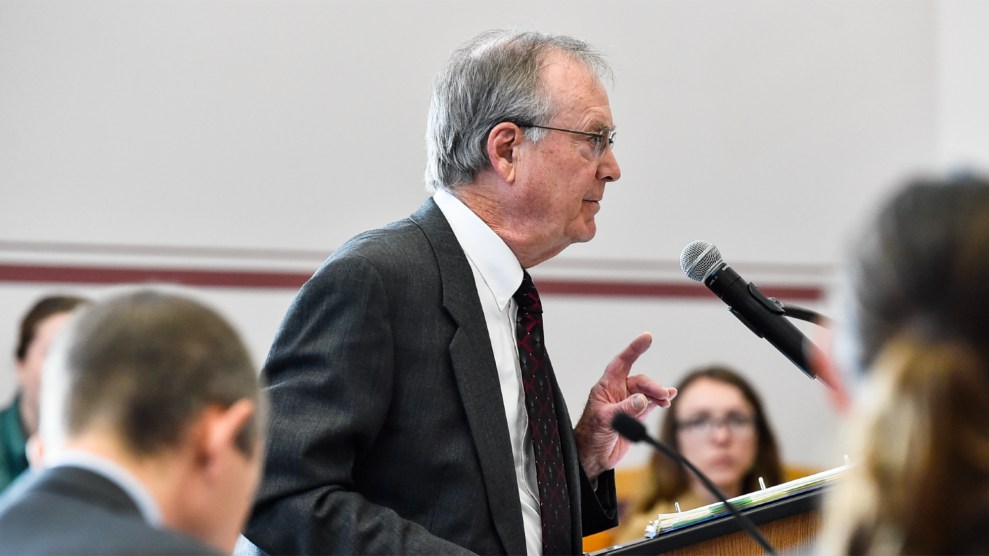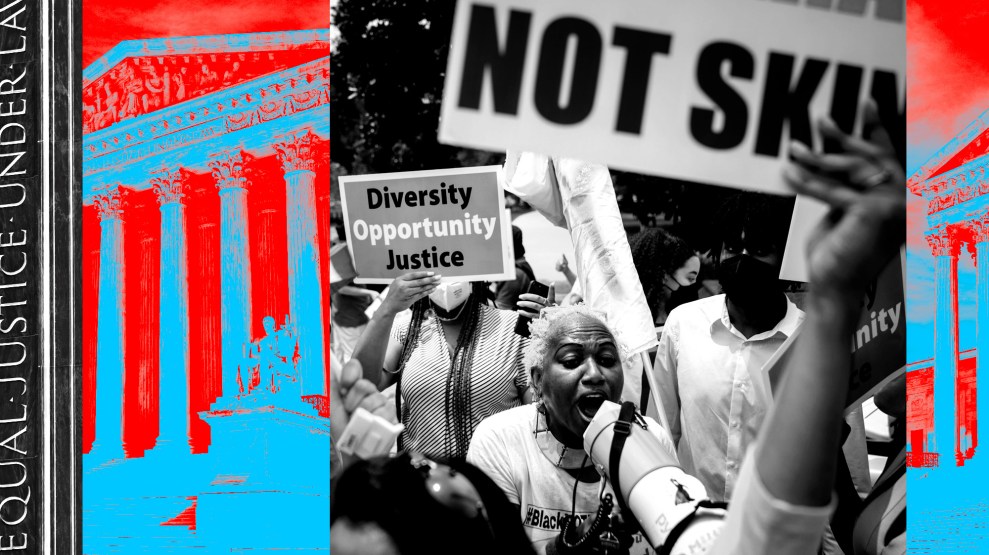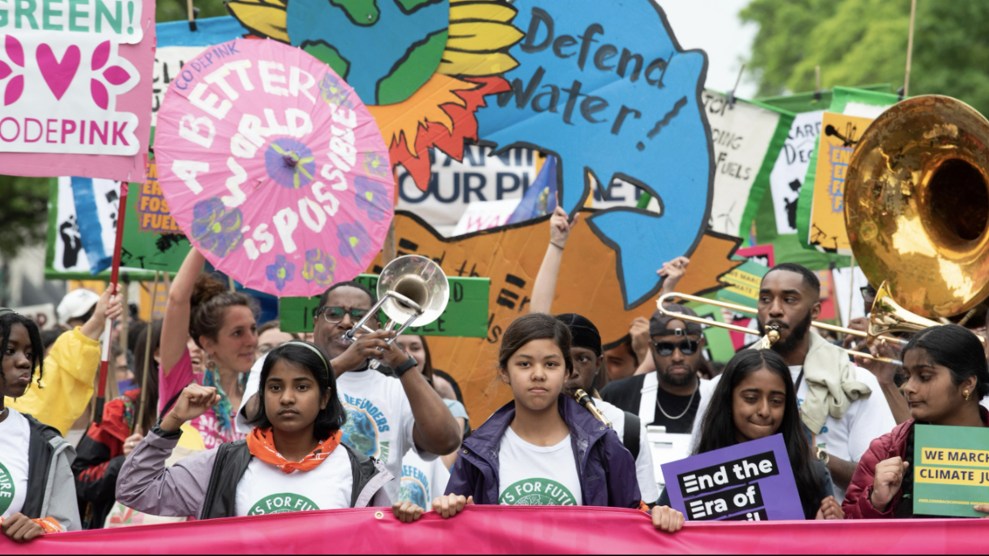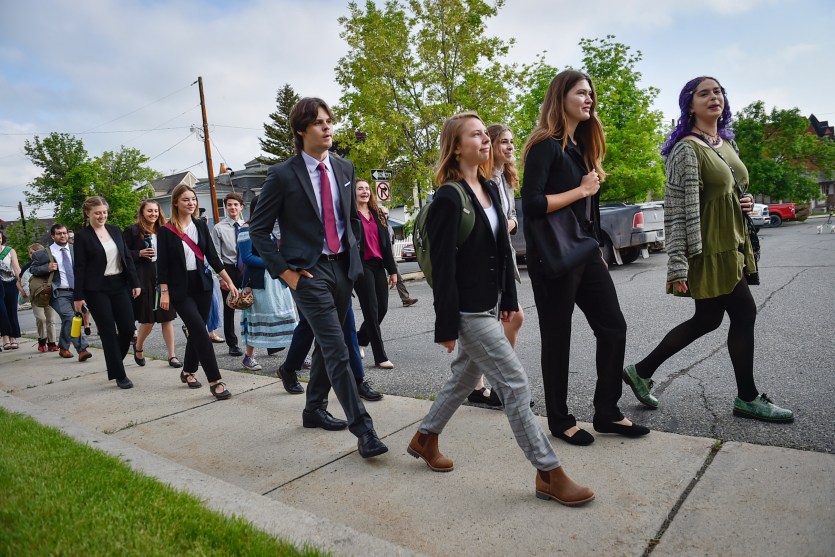
Plaintiff's attorney Roger Sullivan makes an argues for following Montana’s environmental constitutional clause during a status hearing for Held vs. Montana in Helena, Mont., on Friday, May 12, 2023. Thom Bridge/AP
This story was originally published by the Guardian and is reproduced here as part of the Climate Desk collaboration.
A constitutional legal strategy is gaining traction as a way to potentially help bring about climate justice, boosted by a recent high-profile trial in which 16 young plaintiffs spoke movingly about how the climate crisis has affected their lives.
That case, the first US constitutional climate trial, came to an end in Helena, Montana, earlier this month, with a verdict expected to be delivered by a judge in the coming weeks.
Climate and legal advocates say the Montana case—which made national and international headlines—could inspire more legal action, while also pushing forward similar lawsuits pending against four other states and the federal government.
Some climate advocates are, meanwhile, working to enshrine similarly robust environmental rights in other state constitutions, which they say could become the basis of future climate litigation.
The Montana case was filed in March 2020 by 16 youths who allege the state’s government’s climate-damaging energy policies violate the state’s constitution, including provisions guaranteeing that the “state and each person shall maintain and improve a clean and healthful environment in Montana for present and future generations.”
Montana didn’t always guarantee such strong environmental protections. Its first constitution, adopted in 1889, was heavily influenced by mining executives and designed to protect their interests.
“We were very much controlled by a select few corporations, primarily during that time by the hardrock mining industry,” said Derf Johnson, deputy director of the Montana Environmental Information Center advocacy group.
Under its first constitution, Montana was so strongly controlled by extractive industry that historians called the state a “corporate colony.” But in the 1950s and 1960s, Johnson said, the legislature began to recognize the problem.
In 1972, amid rising public concern about the environment, the state convened 100 delegates at a constitutional convention to write a new document. The delegates saw the high levels of pollution the extractive industry had caused, said the retired Montana supreme court justice Jim Nelson, so among their top priorities was shedding this oligarchic control.
“Delegates considered the environment to be very important, and they wanted to preserve that for future generations,” he said.
Montana is one of just three states whose constitutions include what environmental attorney Maya van Rossum calls “green amendments.”
The first state to enshrine a green amendment was Pennsylvania, which did so one year before Montana did in 1971.
In 2021, New York became the third and most recent state to codify such protections when residents overwhelmingly approved a ballot measure amending the state constitution to include the right to “clean air and water, and a healthful environment”.
Other states, including Hawaii, Illinois, Massachusetts, and Rhode Island, have environmental protections in their constitutions that are not in their respective bills of rights. Still other states provide constitutional protections that relate to the environment, including Alaska, where the public has a right to “navigable and public waters.”
But in order to qualify as truly green, said Van Rossum, amendments must meet specific criteria; for instance, they must be placed in the bill of rights section of a state’s constitution to ensure they provide the highest level of protection, and they must be “self-executing,” meaning a legislature does not have to pass laws for the amendments to function.
Van Rossum’s nonprofit, Green Amendment for the Generations, is working with partners in other states to enshrine these provisions in other state constitutions.
The movement notched a victory last week when Delaware’s legislature advanced a measure to adopt a green amendment that would enshrine rights to a “clean and healthy environment, including pure water, clean air, healthy soils, ecologically healthy ecosystems, a livable climate, and to the preservation of the natural, cultural, recreational, scenic and healthful qualities of the environment.” And active campaigns for green amendments are under way in 15 other states, said Van Rossum.
While Van Rossum and climate advocates push to enshrine new constitutional rights, lawyers are also working to use existing ones to deliver climate action.
Our Children’s Trust, the non-profit law firm behind the Montana lawsuit, also has youth-led constitutional climate lawsuits pending against the federal government, as well as four other states: Hawaii, Florida, Utah and Virginia.
“Each of those cases focuses on different attributes of the government’s conduct, but are similar in that those in power continue to take actions that perpetuate dependence on fossil fuels,” said Andrea Rodgers, senior litigation attorney at Our Children’s Trust.
Both the federal suit and the Hawaii suit are expected to go to trial sometime in 2024. Oral arguments—which allow attorneys to clarify and emphasize legal cases—will be held in the Virginia and Utah cases before the end of 2023, Rodgers said.
The firm has not based these lawsuits solely on constitutional environmental protections. In fact, its best-known constitutional climate lawsuit, the federal case Juliana v US, was filed despite the fact that the US Constitution does not include any rights to a clean and healthful environment.
Instead, Juliana v US asserts that by enacting pro-fossil fuel policies and exacerbating climate change, the government violated the plaintiffs’ constitutional rights to life, liberty and property; the principle of “equal protection” under the law; and the public trust doctrine—a legal theory which asserts that governments have a responsibility to preserve certain natural resources for public use and enjoyment. (The public trust doctrine has long formed a basis for youth climate litigation, even playing a role in the first instance of young people suing a federal agency over greenhouse gas emissions, 2011’s Alec L v Jackson.)
Even the Montana lawsuit is not based entirely on the state’s green amendment. “Other constitutional provisions, such as the right to health and individual dignity and equal protection, are also in issue,” said Rodgers.
Asked if green amendments could help create more opportunities for litigation in other states, she said: “Potentially.”
“What is unique about climate change is that it really is not simply an environmental issue,” Rodgers said, noting that during the Montana trial, children testified not only about the loss of natural beauty, but also about their inability to recreate and enjoy basic freedoms. “That is why we focus on ensuring that courts uphold children’s most basic fundamental rights, regardless of whether they are framed in the context of a ‘green amendment.’”
Van Rossum said that though they are not the only way to launch constitutional climate litigation, green amendments could help create a “cleaner case.”
Both strategies can coexist, said Van Rossum. As Hawaii youth prepare to take their own constitutional climate lawsuit to trial, for instance, the state is also in the midst of an active green amendment campaign.
“When we give explicit and clear protection to our climate in the form of a green amendment, it means that youth don’t have to bring evidence that a safe climate is their right because the constitution says it,” Van Rossum said.
In some states, including Hawaii, advocates have proposed green amendment proposals that explicitly protect the right to a stable climate.
“As we also see with abortion rights and gun rights and the Held v Montana case, there is nothing more powerful and beneficial than having an explicit and clear constitutional right in the bill of rights section of the constitution,” Van Rossum said. “Green amendments, particularly those that explicitly recognize a safe climate as an inalienable, human right entitled to highest constitutional protection, avoid the need to prove that a stable climate should be included in the definition.”














